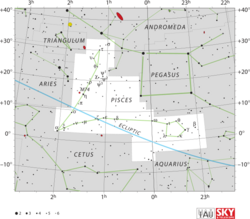Astronomy:Rho Piscium
| Observation data Equinox J2000.0]] (ICRS) | |
|---|---|
| Constellation | Pisces |
| Right ascension | 01h 26m 15.26209s[1] |
| Declination | +19° 10′ 20.4526″[1] |
| Apparent magnitude (V) | +5.344[2] |
| Characteristics | |
| Spectral type | F2 V[3] |
| B−V color index | +0.374[2] |
| Astrometry | |
| Radial velocity (Rv) | −7.7±1.0[4] km/s |
| Proper motion (μ) | RA: −26.89[1] mas/yr Dec.: +11.12[1] mas/yr |
| Parallax (π) | 39.66 ± 0.25[1] mas |
| Distance | 82.2 ± 0.5 ly (25.2 ± 0.2 pc) |
| Absolute magnitude (MV) | +3.34[5] |
| Details | |
| Mass | 1.31[6] M☉ |
| Radius | 1.1[7] R☉ |
| Luminosity | 3.6[8] L☉ |
| Surface gravity (log g) | 4.41±0.14[6] cgs |
| Temperature | 6,822±232[6] K |
| Metallicity [Fe/H] | −0.31[9] dex |
| Rotational velocity (v sin i) | 60.1[10] km/s |
| Age | 778[6] Myr |
| Other designations | |
| Database references | |
| SIMBAD | data |
Rho Piscium (ρ Piscium) is a solitary,[12] yellow-hued star in the zodiac constellation of Pisces. With an apparent visual magnitude of +5.34,[2] it is faintly visible to the naked eye. Based upon an annual parallax shift of 39.66 mas as seen from Earth,[1] it is located 82 light years from the Sun. It is a member of the thin disk population of the Milky Way.[9]
This is an F-type main sequence star with a stellar classification of F2 V.[3] It is a suspected variable star that ranges in magnitude from a maximum of 5.35 to a minimum of 5.44 magnitude.[13] The star is a source of X-ray emission with a luminosity of 117.6×1020 W.[14] It is 778[6] million years old and is spinning with a projected rotational velocity of 60.1 km/s.[10] The star has 1.3[6] times the mass of the Sun and about 1.1[7] times the Sun's radius. It is radiating 3.6[8] times the Sun's luminosity from its photosphere at an effective temperature of 6,822 K.[6]
Naming
In Chinese, 右更 (Yòu Gèng), meaning Official in Charge of the Pasturing, refers to an asterism consisting of ρ Piscium, η Piscium, π Piscium, ο Piscium and 104 Piscium. Consequently, the Chinese name for ρ Piscium itself is 右更一 (Yòu Gèng yī, English: the First Star of Official in Charge of the Pasturing.)[15]
References
- ↑ 1.0 1.1 1.2 1.3 1.4 1.5 van Leeuwen, F. (2007), "Validation of the new Hipparcos reduction", Astronomy and Astrophysics 474 (2): 653–664, doi:10.1051/0004-6361:20078357, Bibcode: 2007A&A...474..653V.
- ↑ 2.0 2.1 2.2 Høg, E. et al. (March 2000), "The Tycho-2 catalogue of the 2.5 million brightest stars", Astronomy and Astrophysics 355: L27–L30, doi:10.1888/0333750888/2862, Bibcode: 2000A&A...355L..27H.
- ↑ 3.0 3.1 Gray, R. O. et al. (July 2006), "Contributions to the Nearby Stars (NStars) Project: Spectroscopy of Stars Earlier than M0 within 40 parsecs: The Northern Sample I", The Astronomical Journal 132 (1): 161–170, doi:10.1086/504637, Bibcode: 2006AJ....132..161G.
- ↑ de Bruijne, J. H. J.; Eilers, A.-C. (October 2012), "Radial velocities for the HIPPARCOS-Gaia Hundred-Thousand-Proper-Motion project", Astronomy & Astrophysics 546: 14, doi:10.1051/0004-6361/201219219, A61, Bibcode: 2012A&A...546A..61D.
- ↑ Anderson, E.; Francis, Ch. (2012), "XHIP: An extended hipparcos compilation", Astronomy Letters 38 (5): 331, doi:10.1134/S1063773712050015, Bibcode: 2012AstL...38..331A.
- ↑ 6.0 6.1 6.2 6.3 6.4 6.5 6.6 David, Trevor J.; Hillenbrand, Lynne A. (2015), "The Ages of Early-Type Stars: Strömgren Photometric Methods Calibrated, Validated, Tested, and Applied to Hosts and Prospective Hosts of Directly Imaged Exoplanets", The Astrophysical Journal 804 (2): 146, doi:10.1088/0004-637X/804/2/146, Bibcode: 2015ApJ...804..146D.
- ↑ 7.0 7.1 Pasinetti Fracassini, L. E. et al. (2001), "Catalogue of Apparent Diameters and Absolute Radii of Stars (CADARS)", Astronomy & Astrophysics 367: 521–24, doi:10.1051/0004-6361:20000451, Bibcode: 2001A&A...367..521P.
- ↑ 8.0 8.1 McDonald, I. et al. (2012), "Fundamental Parameters and Infrared Excesses of Hipparcos Stars", Monthly Notices of the Royal Astronomical Society 427 (1): 343–57, doi:10.1111/j.1365-2966.2012.21873.x, Bibcode: 2012MNRAS.427..343M.
- ↑ 9.0 9.1 Ibukiyama, A.; Arimoto, N. (November 2002), "HIPPARCOS age-metallicity relation of the solar neighbourhood disc stars", Astronomy and Astrophysics 394: 927–941, doi:10.1051/0004-6361:20021157, Bibcode: 2002A&A...394..927I.
- ↑ 10.0 10.1 Schröder, C.; Reiners, Ansgar; Schmitt, Jürgen H. M. M. (January 2009), "Ca II HK emission in rapidly rotating stars. Evidence for an onset of the solar-type dynamo", Astronomy and Astrophysics 493 (3): 1099–1107, doi:10.1051/0004-6361:200810377, Bibcode: 2009A&A...493.1099S, http://goedoc.uni-goettingen.de/goescholar/bitstream/handle/1/9690/aa10377-08.pdf?sequence=2[yes|permanent dead link|dead link}}]
- ↑ "rho Psc". SIMBAD. Centre de données astronomiques de Strasbourg. http://simbad.u-strasbg.fr/simbad/sim-basic?Ident=rho+Psc.
- ↑ Eggleton, P. P.; Tokovinin, A. A. (September 2008), "A catalogue of multiplicity among bright stellar systems", Monthly Notices of the Royal Astronomical Society 389 (2): 869–879, doi:10.1111/j.1365-2966.2008.13596.x, Bibcode: 2008MNRAS.389..869E.
- ↑ Samus, N. N. et al. (2017), "General Catalogue of Variable Stars", Astronomy Reports, GCVS 5.1 61 (1): 80–88, doi:10.1134/S1063772917010085, Bibcode: 2017ARep...61...80S.
- ↑ Huensch, M. et al. (October 1998), "The ROSAT all-sky survey catalogue of optically bright main-sequence stars and subgiant stars", Astronomy and Astrophysics Supplement 132 (2): 155–171, doi:10.1051/aas:1998287, Bibcode: 1998A&AS..132..155H.
- ↑ (in Chinese) AEEA (Activities of Exhibition and Education in Astronomy) 天文教育資訊網 2006 年 5 月 19 日
 |


